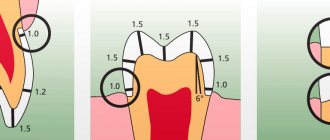Content
- What crowns are used?
- Comparison of zirconium and metal-ceramic crowns
- How to choose material
- The best dentures
Restoring missing teeth is a labor-intensive and quite expensive process. In addition, there are a lot of options and choosing the right one without the appropriate knowledge is problematic. Often, patients have to choose a crown for a tooth made of zirconium or metal-ceramics, since these are the options that are used most often than others.
What kind of crowns are used?
- Plastic crowns are a temporary option. They do not have sufficient strength and aesthetic qualities, they wear out quickly, change color, and become covered with plaque.
- Ceramics are an option for cases where aesthetics take precedence over durability. For use on front teeth only. Due to the absence of metal, crowns are almost indistinguishable from natural teeth, but at the same time they have low strength.
- Metal ceramics – crowns with a metal base, covered with a layer of hypoallergenic ceramic mass. They are universal, quite aesthetic, but not without drawbacks. Among them is the possibility of darkening of the gums at the junction with the crown (due to chemical reactions), as well as the transmission of metal through the ceramic layer. Crowns for any teeth and bridges are made from metal ceramics.
- Crowns based on zirconium dioxide. These are high-tech systems that are both durable and aesthetic. These artificial teeth have a good level of transparency, making them look very natural. These crowns are used for any teeth and bridges.
Basically, metal-ceramics or zirconium dioxide are used for prosthetics at Amazing Price Dentistry. Both options are durable, have good aesthetics, and with proper care last a long time. However, this does not mean that we work with templates - for each specific case, a solution is selected that best meets the requirements of durability, aesthetics and the patient’s budget.
PROMOTION
Ceramic crowns, bridges
RUB 11,500
Metal-ceramic crowns
Metal ceramics is a material that includes two components:
- Metal (most often an alloy of chromium and cobalt).
- A ceramic coating that is applied and fired in layers to ensure hardness.
Thanks to this manufacturing method, metal-ceramics can be called a certain compromise between strength (this is achieved due to the metal base) and aesthetics, which is provided by the ceramic coating. This combination of reliability and aesthetics is the main advantage of metal-ceramic structures.
Installation of metal-ceramics requires adherence to a certain technique and the formation of a ledge when turning a tooth.
In addition, the advantages include a fairly long service life, which with proper care reaches ten years. Finally, the decisive factor in popularity is the low price. At the same time, metal-ceramic structures have very noticeable disadvantages :
- Their installation requires adherence to a certain technique and the formation of a ledge when turning the tooth. Otherwise, it is possible that the dentures will not last long, and inflammation will begin at their junction with the gums. Not all orthopedists are proficient in the technique of forming a ledge.
- The aesthetics are not bad, but leave much to be desired, since the material does not allow light to pass through. Therefore, if a single denture is placed on one tooth in the anterior row, it will be noticeable. In addition, the metal has its own shade, and it is not always possible to disguise it with an outer layer of ceramics. The optimal (but unreasonably expensive) choice in this case would be to choose gold, the yellowness of which will bring the color of the prosthesis as close as possible to the shade of natural teeth.
- The gums in contact with the crown tend to recede. Some time after installation, a dark metal rim appears in this place.
- Installation of metal ceramics in the oral cavity requires significant grinding, since the thickness of the material is large.
- In most cases, depulpation is performed, even if the tooth pulp is healthy. This is due to the depth of grinding: it is large, and the doctor, by inaccurately calculating the amount of tissue to be grinded, risks burning the pulp.
- The rigidity of dentures negatively affects the opposing teeth, which begin to wear away.
Comparison of zirconium and metal ceramics
To understand the difference between metal-ceramics and zirconium, here is a comparative table:
| Metal ceramics | Zirconium dioxide | |
| Price | Average | High |
| Presence of metal | Metal present, galvanic reactions possible | No metal |
| Possibility of allergies | Present due to the metal (reduced if a precious metal alloy is used) | No |
| Durability | 10-15 years | 15 – 20 years |
| Manufacturability | Made by hand | Application of high-tech computer equipment |
| Aesthetics | Fairly high level, can show through metal in certain lighting | Maximum naturalness, adjustable level of transparency |
| Strength | High | High |
| Preparing teeth for a crown | Strong grinding, removal of quite a large layer | Gentle treatment due to the design features and thin walls of the crowns |
Analyzing the data presented in the table, we can say that metal ceramics are better than zirconium only in terms of price. Indeed, the cost of restoring teeth in the oral cavity, especially large numbers, in the zirconium version will be significantly more expensive. However, if you focus not only on price, zirconium wins noticeably.
- Durability When comparing the service life of zirconium and metal-ceramics, we can nominally say that the first material will last twice as long. In practice, this figure is higher, and with proper oral care, zirconium bridges and crowns will serve their owners for a lifetime.
- Hypoallergenic Zirconium does not contain metallic inclusions, which means its range of applications is wider. In particular, such prostheses can be installed in “problem” categories of patients, including those with allergies to base metals. Let us immediately make a reservation that gold ceramics are also suitable for allergy sufferers, but their strength indicators are lower than those of zirconium dioxide orthopedic structures.
- Precision of the prosthesis The fact that a metal-ceramic prosthesis is made by dental technicians determines the likelihood (albeit minimal) of errors that will manifest themselves in a loose fit of the structure, and as a result - in a low level of comfort, rubbing of the mucous membrane and long-term adaptation. In the case of zirconium, the human factor is completely excluded. First, the oral cavity is scanned with a special scanner, then the resulting digital model is loaded into the milling machine program. As a result, a bridge or crown made of zirconium absolutely precisely matches the anatomical features of the dentition.
- Safety The purpose of installing a crown is to restore the damaged part of the tooth and help extend its working life. But unfortunately, this is not always what happens. There are situations when a tooth that has been heavily ground for a prosthesis becomes the next candidate for removal. Especially if, in preparation for prosthetics, a nerve had to be removed from it. A metal-ceramic crown consists of two layers - the first is metallic and has a gray tint, so the ceramic is applied to it in a rather thick layer to cover the gray tint. In this regard, it is necessary to remove a large layer of enamel, and often depulpate the tooth. The structural features of zirconium determine the need to remove a very thin enamel layer, and in 99% of cases they do not require nerve removal.
- Comfort It would seem that both metal ceramics and zirconium have a top ceramic layer that is ideally smooth. But the zirconium prosthesis has much less weight. Patients whose metal-ceramic bridges were replaced with zirconium bridges after wear, note the amazing lightness and high comfort of the new design.
Care and service life
If we are talking about solid-cast ceramics (and not ceramics with a frame made of zirconium dioxide or aluminum oxide), its strength is still inferior to a metal-ceramic product. The service life is determined to be 5-8 years, subject to proper care and compliance with doctor’s recommendations.
It is important to brush your teeth regularly, avoid using floss (or use it very carefully) to avoid “removing” the crown, and do not forget about the need for professional cleaning every 3-4 months.
How to choose a material for a denture?
The differences between metal-ceramics and zirconium determine the area in which the crowns will be installed. If prosthetics will be performed on chewing teeth and the patient is not inclined to spend too much, metal-ceramic crowns will be an excellent durable option.
If we are talking about the front teeth, you should pay attention to zirconium dentures. In the smile area, not only crowns are important, but also the condition of the gums. As can be seen from the table, one of the differences between metal ceramics and zirconium is the possibility of undesirable reactions of the metal with tissues, darkening of the gums. And this is extremely undesirable in the frontal zone of the dentition.
Features of zirconium crowns
Zirconium has been used in dentistry for about two decades. The popularity of the material is due to its ability to transmit light, which makes the prosthesis as close in appearance to a natural tooth as possible.
Crowns made from zirconium dioxide have a number of advantages:
- Crowns made of zirconium dioxide – no negative reaction of the body to zirconium
excellent aesthetic effect (no differences from natural teeth);
- slight restrictions on the use of the material;
- no negative reaction of the body to zirconium;
- tight contact with the gum, absence of cracks and compressive effect eliminates the development of complications;
- gentle installation technique that does not require deep grinding of dental tissue;
- high strength of zirconium dioxide, which makes it possible to make the frame more elegant, and the fit of the crown to the adjacent tooth is precise;
- zirconium is suitable for prosthetics of anterior incisors and chewing molars;
- long operational period.
Almost the only drawback of crowns is their high cost, which is due to the complexity of the manufacturing process and the use of innovative 3D technology.
Installation of prostheses made of zirconium material is recommended in the following cases:
- in the presence of aesthetic defects of individual teeth (problems with bone tissue);
- if dental implantation is required;
- to correct dental defects;
- in cases of prosthetics when it is not possible to use crowns made of another material.
There are few contraindications to the installation of zirconium crowns, but they should be taken into account when performing prosthetics.
With a pronounced deep bite and involuntary grinding of teeth, the material will quickly become damaged, which will require repeated treatment. You should not choose zirconium dioxide even in cases where the height in the area of the connectors of the bridge structure is insignificant (small teeth).
You should not choose zirconium dioxide even in cases where the height in the area of the connectors of the bridge structure is insignificant (small teeth)










